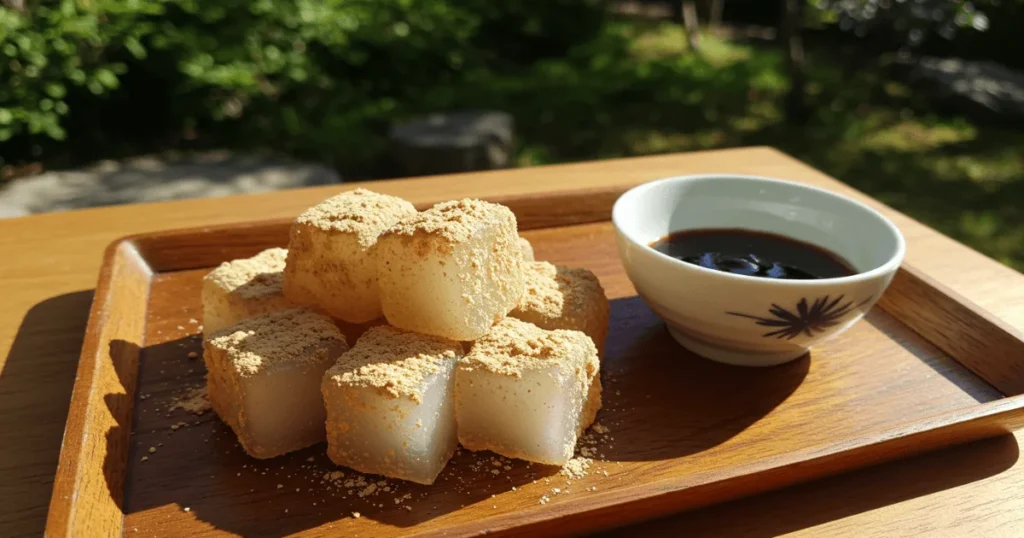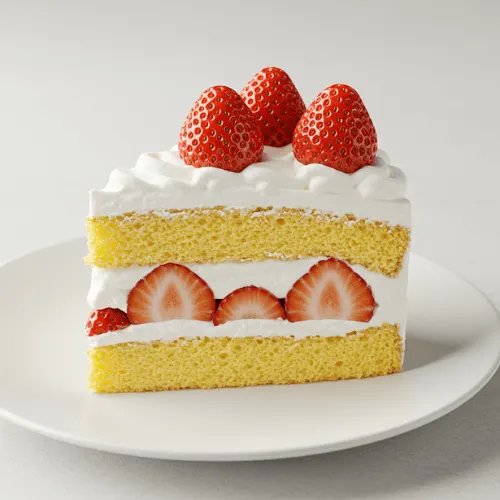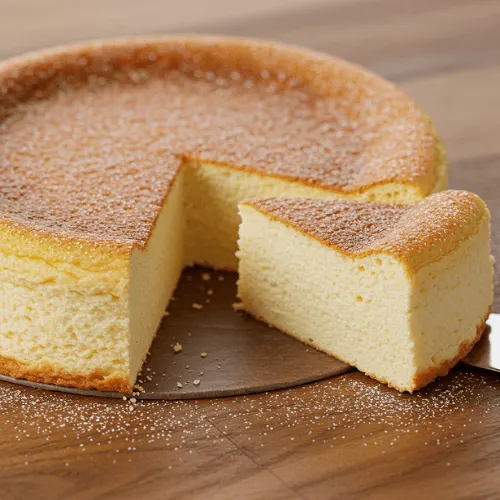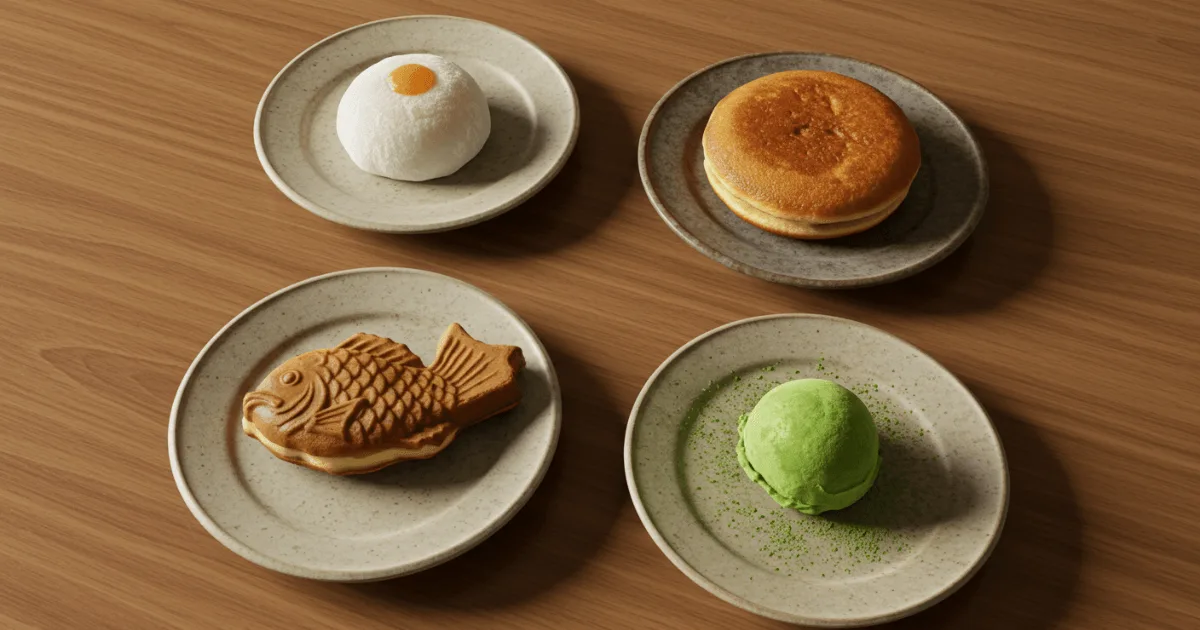Have you ever tried Japanese desserts? They’re truly something else. That wobbly cheesecake that feels like you’re eating a cloud, or mochi—those soft, chewy bites that make you smile without thinking. What I love is how they’re sweet but never overwhelming; each one feels like it was made with real care. Some recipes are older than your great-grandma, while others are cool new creations, but they all share that special Japanese touch.
I picked out nine amazing ones that’ll make you want to:
- Fly to Japan immediately
- Raid your local Asian market
- Try making them yourself
Trust me, your sweet tooth will thank you. Let’s get started!
Table of Contents
The Charm of Japanese Desserts
Japanese desserts are different—quiet but unforgettable. They whisper with delicate flavors and playful textures instead of shouting with sugar. Here’s why I love them:
- They’re almost too pretty to eat (but you will)
- You perceive the actual ingredients, beyond just the sweet flavor.
- They change with the seasons—cherry blossoms in spring, cozy sweet potatoes in fall
- Some recipes date back centuries, long before your great-grandma’s time.
- They make you slow down and savor every bite—no mindless snacking here
Each one feels like a tiny, delicious moment worth remembering.
9 Bold Japanese Desserts You Can’t Miss
1. Mochi: The Chewy Staple of Japanese Sweets
Mochi is Japan’s chewy, stretchy rice dough—pure comfort in every bite. But there’s not just one type.
Key Benefits:
- Gluten-free and low in fat
- Halal-friendly when using anko or fruit fillings
- Rich in cultural tradition and symbolism
- Customizable with various fillings (e.g., anko, fruit, ice cream)
- Satisfyingly chewy texture, unique to Japanese desserts
Ingredients:
| Ingredient | Quantity |
|---|---|
| Glutinous rice flour | 1 cup |
| White sugar | 1/4 cup |
| Water | 3/4 cup |
| Potato starch/cornstarch | As needed (for dusting) |
| Anko (red bean paste) | ~1/2 cup, divided into balls |
Instructions:
- Scoop anko into 1-tablespoon balls and chill to firm.
- Mix rice flour, sugar, and water in a microwave-safe bowl until smooth.
- Microwave for 1 minute, stir, then repeat twice more (total 3 minutes).
- Dust a surface with starch, pour the mochi dough onto it, and dust the top.
- Separate into 6–8 pieces and shape each one into a flat disc.
- Place an anko ball at the center of each disc and pinch the edges to close them.
- Flip seam-side down and gently shape into smooth balls.
2. Warabi Mochi: Delicate, Cool & Jelly-Like
Unlike regular mochi, Warabi mochi is a translucent, jelly-like treat made using bracken starch. It’s typically served chilled with:
- Kinako powder (roasted soybean flour)
- Kuromitsu syrup (dark sugar molasses)
Key Benefits:
- Great chilled dessert
- Silky, jelly texture
- Easy to digest
- Looks beautiful when served
- Naturally gluten-free
Ingredients:
| Ingredient | Quantity |
|---|---|
| Warabi starch | 1/2 cup |
| Sugar | 1/4 cup |
| Water | 2 cups |
| Kinako (roasted soybean flour) | 2 tbsp |
| Kuromitsu syrup | 2 tbsp |
Instructions:
- Combine warabi starch, sugar, and water in a saucepan.
- Stir constantly over medium heat until it thickens and becomes translucent.
- Pour into a mold or tray, cool, and cut into cubes.
- Dust with kinako and drizzle with kuromitsu.
It’s a Kansai specialty and a summer must-try. Think of it as Japan’s answer to jelly desserts—but elevated.

3. Dorayaki: Pancakes With a Sweet Twist
Dorayaki are fluffy pancake sandwiches with sweet red bean bliss. You’ll often find variations:
- Matcha-flavored pancakes
- Custard or chocolate fillings
- Even ice cream-stuffed dorayaki in trendy cafes
Key Benefits:
- Portable and kid-friendly
- Iconic and nostalgic (Doraemon’s favorite!)
- Customizable fillings (chocolate, custard, matcha)
- Rich in protein from eggs
- Light yet satisfying
Ingredients:
| Ingredient | Quantity |
|---|---|
| Eggs | 2 |
| Sugar | 1/2 cup |
| Honey | 1 tbsp |
| All-purpose flour | 1 cup |
| Baking powder | 1 tsp |
| Water | 2 tbsp (adjust as needed) |
| Anko paste | ~1/2 cup |
Instructions:
- Beat eggs, sugar, and honey until light and frothy.
- Mix flour and baking powder, then slowly combine with the egg mixture.
- Let the batter rest for 15–30 minutes.
- Heat a non-stick pan over medium heat. Pour batter to form small pancakes.
- Cook 1–2 minutes per side until golden.
- Let cool slightly. Spread anko on one pancake and top with another.
4. Matcha Ice Cream: Bitter-Sweet Obsession
Matcha ice cream is earthy, creamy green tea bliss.
Why You’ll Love It:
- Pairs beautifully with warm pastries
- Lower in sugar than Western ice creams
- Loaded with antioxidants (yes, dessert can be guilt-free!)
Key Benefits:
- Rich in antioxidants (from matcha)
- Lower sugar than traditional ice cream
- Elegant bitterness balances sweetness
- Perfect after-meal dessert
- Naturally green (no dyes)
Ingredients:
| Ingredient | Quantity |
|---|---|
| Heavy cream | 1 cup |
| Whole milk | 1 cup |
| Sugar | 2/3 cup |
| Egg yolks | 3 |
| Matcha powder | 2 tbsp |
Instructions:
- Whisk egg yolks and sugar until pale.
- Warm the milk and cream in a saucepan until they begin to simmer.
- Slowly whisk hot milk into egg yolks.
- Place back in the pot and simmer on low, stirring continuously until it thickens.
- Turn off the heat and blend in the matcha powder.
- Allow to cool fully, then process in an ice cream maker.
5. Taiyaki: A Fish That’s All About Filling
Taiyaki, a fish-shaped waffle, is stuffed with treats such as:
- Sweet red bean paste
- Custard
- Chocolate or matcha cream
Key Benefits:
- Street food favorite
- Crispy outside, soft inside
- Versatile fillings
- Fun for kids and parties
- Tastes great warm
Ingredients:
| Ingredient | Quantity |
|---|---|
| All-purpose flour | 1 cup |
| Baking powder | 1 tsp |
| Sugar | 1 tbsp |
| Milk | 3/4 cup |
| Egg | 1 |
| Filling (anko or custard) | ~1/2 cup |
Instructions:
- In a bowl, mix flour, sugar, and baking powder.
- Whisk in egg and milk until smooth.
- Preheat the taiyaki mold or fish-shaped waffle pan.
- Add batter to the mold, drop a spoonful of filling in the center, and cover it with extra batter.
- Fry each side for 2–3 minutes until they are golden and have a crispy finish.
If you’re lucky, you’ll find one stuffed with Japanese pudding—rich, jiggly, and unexpectedly addictive.
6. Daifuku: Little Bites of Joy
Daifuku is soft mochi hiding sweet surprises inside:
- Anko bean paste
- Fresh fruit (like whole strawberries)
- Or even ice cream
Key Benefits:
- Seasonal and refreshing
- Simple but impressive
- Combining fruit and traditional filling
- Great for spring events
- Kid- and guest-friendly
Ingredients:
| Ingredient | Quantity |
|---|---|
| Mochiko (sweet rice flour) | 1 cup |
| Sugar | 1/4 cup |
| Water | 3/4 cup |
| Fresh strawberries | 6–8 whole, hulled |
| Anko paste | ~1/2 cup |
| Cornstarch | As needed |
Instructions:
- Coat each strawberry with a layer of anko and refrigerate.
- Mix mochiko, sugar, and water; microwave as with basic mochi.
- Sprinkle starch on the surface and move the mochi dough onto it.
- Cut into 6–8 portions and flatten each.
- Position the strawberry-anko ball, seam side down, within a mochi dome.
The Ichigo Daifuku—with a whole strawberry inside—is the star of spring festivals in Japan. Sweet, juicy, and wrapped in soft mochi, it’s a flavor bomb you won’t forget.
7. Anmitsu: Summer’s Jelly Dessert
Looking for something cool, light, and still satisfying? Anmitsu is your pick. This refreshing dessert includes:
- Cubes of agar-agar jelly
- Fruits like melon or mandarin
- Little mochi balls
- A scoop of anko bean paste
- A drizzle of black sugar syrup
Key Benefits:
- Light and hydrating
- Naturally vegan
- Refreshing in hot weather
- Contains fruit and fiber
- Easy to customize
Ingredients:
| Ingredient | Quantity |
|---|---|
| Agar-agar powder | 1 tsp |
| Water | 1 cup |
| Mixed fruit (melon, orange, peach) | 1 cup |
| Anko paste | 1/4 cup |
| Mochi balls | 4–6 small pieces |
| Kuromitsu syrup | 2 tbsp |
Instructions:
- Heat agar powder in water until it boils, then pour it into the mold and allow it to solidify.
- Cut into cubes. In a bowl, arrange jelly, fruit, mochi, and anko.
- Drizzle kuromitsu before serving.
It’s not just a dessert—it’s a beautiful, balanced bowl of textures and temperatures. If you’re visiting Japan in summer, it’s almost a ritual.
8. Yatsuhashi: Kyoto’s Spiced Delight
This triangular treat is a Kyoto souvenir staple. Yatsuhashi comes in two forms:
- Baked: crispy like a cinnamon cookie
- Raw (Nama Yatsuhashi): soft mochi filled with red bean or matcha paste
Key Benefits:
- Kyoto traditional souvenir
- No baking needed for the soft version
- Fragrant cinnamon profile
- Vegan-friendly
- Unique shape
Ingredients:
| Ingredient | Quantity |
|---|---|
| Mochiko (rice flour) | 1/2 cup |
| Sugar | 2 tbsp |
| Water | 1/4 cup |
| Cinnamon powder | 1/2 tsp |
| Anko paste | 1/4 cup |
Instructions:
- Mix mochiko, sugar, cinnamon, and water; microwave until the consistency is doughy.
- Dust the surface with cornstarch and roll the dough thin.
- Cut into squares, fill each with a bit of anko, and fold into triangles.
If you’re walking Kyoto’s old streets, you’ll smell it before you see it. Warm cinnamon, chewy texture, and sweet fillings—yes, please.
9. Castella: A Legacy From Portugal
Castella is a light, golden sponge cake from Nagasaki, subtly sweet and perfect with tea.
Key Benefits:
- Airy and moist texture
- Mild sweetness
- Great with tea or coffee
- Kid-approved
- Keeps well when stored
Ingredients:
| Ingredient | Quantity |
|---|---|
| Eggs | 4 |
| Sugar | 3/4 cup |
| Bread flour | 1 cup |
| Honey | 2 tbsp |
| Warm milk | 2 tbsp |
Instructions:
- Preheat oven to 160°C (320°F).
- Beat eggs and sugar until thick and pale (ribbon stage).
- Add honey and milk, then gently fold in sifted flour.
- Pour into a lined loaf pan and tap to release air bubbles.
- Bake for 35–40 minutes. Cool before slicing.
Whether you go traditional or modern, Castella is always a soft, satisfying finale.
Craving Japanese Cheesecake Instead?
Uncle Tetsu’s legendary cheesecake is jiggly, cloud-soft, and utterly irresistible.
What makes it different?
- Less cream cheese, more whipped egg whites
- Baked in a water bath
- Almost soufflé-like texture
If you’ve ever had Japanese pudding, imagine that in cake form—and you’ll understand the hype.
Explore More: Strawberry Shortcake Japan Style
Let’s not forget Japan’s version of a classic: Strawberry Shortcake.
Layers of:
- Fluffy Japanese sponge cake
- Lightly sweetened whipped cream
- Fresh strawberries
It’s the go-to celebration cake in Japan. Simple, soft, and elegant—a perfect representation of Japanese baking values.


Your Sweet Journey Starts Now
Now that you’ve navigated through Japan’s most cherished confections, the only question is: Which one will you try first?
- Share this article with your foodie friends.
- Try one recipe at home.
- Or better yet—book that trip and taste them fresh.
And if you’ve already fallen for mochi desserts or can’t stop dreaming about Japanese cheesecake, leave a comment below. Let’s talk dessert dreams.
FAQs: All About Japanese Desserts
What Japanese desserts will make my taste buds happy?
Oh, honey, you’re in for a treat! Japan’s dessert game is strong with:
- Mochi – The ultimate chewy delight
- Dorayaki – Like a pancake sandwich with sweet bean surprises
- Matcha ice cream – Earthy, creamy perfection
- Taiyaki – Fish-shaped cakes that are too cute to eat (but you will!)
- Daifuku – Mochi’s stuffed cousin (try the strawberry version!)
- Anmitsu – A jelly fruit party in a bowl
- Castella – Fluffy sponge cake that melts in your mouth
What’s the fancy name for traditional Japanese sweets?
Meet wagashi—Japan’s edible art! These aren’t just sweets, they’re:
- Mini masterpieces (mochi, yokan, manju)
- Tea’s best friend
- Seasonal showstoppers (cherry blossom shapes in spring!)
While we’re at it, what Chinese desserts should I know?
Don’t sleep on these Chinese treats:
- Mooncakes (festive and dense)
- Sesame balls (crispy outside, sweet inside)
- Egg tarts (buttery bliss)
- Almond tofu (silky smooth)
- Mango pudding (tropical vibes)
- …and five more that’ll make your sweet tooth dance!
What’s Japan’s dessert mascot?
Mochi for the win! It’s:
- The life of every party
- Comes in endless varieties
- Symbolizes good luck
Does Japan have an official national sweet?
Think of wagashi as Japan’s sweet ambassador—it tells stories through:
- Centuries-old traditions
- Seasonal beauty
- Delicate flavors that dance on your tongue
Mochi or tteok—what’s the deal?
Cultural cousins alert!
🇯🇵 Mochi = Japanese sweetheart
🇰🇷 Tteok = Korean counterpart (often savory)

